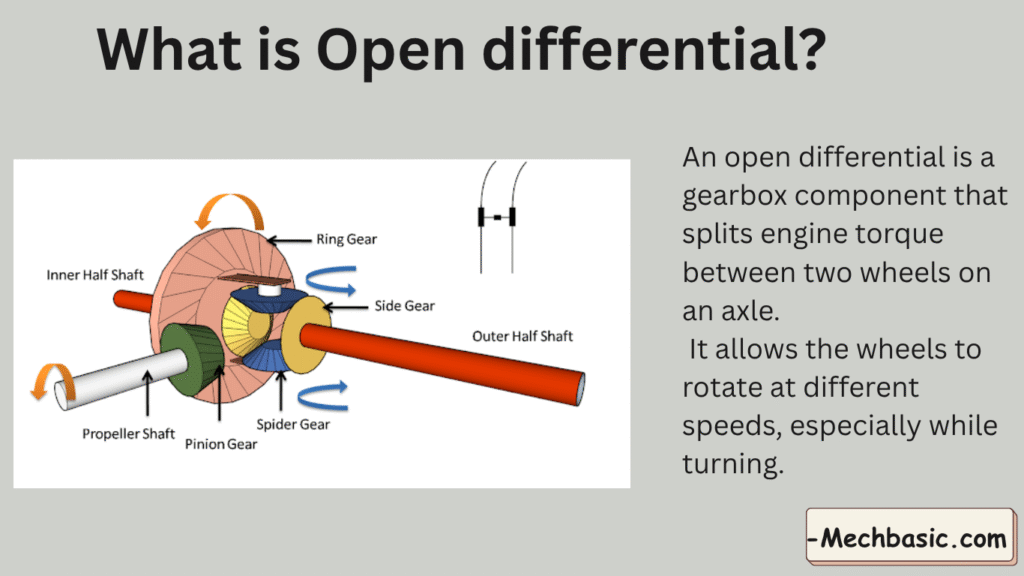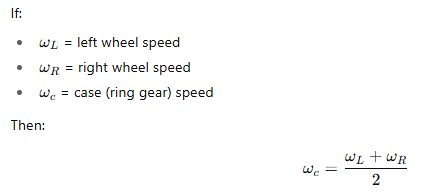In this article, we explain open differentials its construction along with its working g and animation.

In this article:
What is open differentials?
An open differential is a gearbox component that splits engine torque between two wheels on an axle.
It allows the wheels to rotate at different speeds, especially while turning.
However, it sends more power to the wheel with less traction, which can reduce performance on slippery surfaces.
Construction of an Open Differential
An open differential is the simplest and most common type of differential used in most passenger cars.
Main Components:
- Differential Case (or Carrier)
- The housing that holds the internal gears.
- Bolted to the ring gear, which receives torque from the drive pinion (connected to the driveshaft).
- Pinion Gear (Drive Pinion)
- Driven by the driveshaft.
- Engages the ring gear to transmit torque into the differential case.
- Side Gears (Sun Gears)
- Connected to the ends of the axle shafts (one for each wheel).
- Spider Gears (Planet Gears)
- Two (sometimes four) small bevel gears mounted on a cross-shaft inside the case.
- These mesh with both side gears and allow differential action.
Working Principle of an Open Differential
Let’s see how it behaves in three situations:
1. Straight-line driving
- Both wheels experience equal resistance.
- The spider gears do not rotate on their own axis — they simply spin together with the case.
- The side gears (and therefore both wheels) rotate at the same speed.
➡️ Power is split equally between both wheels.
2. Turning
- The inner wheel faces more resistance (shorter path, higher traction).
- The outer wheel faces less resistance (longer path, needs to rotate faster).
- The spider gears rotate on their own axes, allowing one side gear to turn faster than the other.
- The average speed of both side gears remains equal to the speed of the differential case.
➡️ Torque is distributed equally, but speeds differ between wheels.
3. When one wheel loses traction (e.g., stuck on ice)
- The open differential always sends equal torque to both wheels.
- However, since torque is limited by the wheel with least resistance, if one wheel spins freely, the other wheel gets very little torque.
➡️ Vehicle may not move, even though one wheel is spinning fast.
Torque and Speed Relationships

Torque output to each wheel is the same, but speeds differ depending on traction.
Advantages of Open Differential
✅ Simple and inexpensive design
✅ Smooth operation
✅ Effective during normal driving conditions
✅ Low maintenance requirements
Disadvantages
❌ Poor traction when one wheel slips — torque is wasted on the spinning wheel
❌ Not ideal for off-road or performance applications
❌ Cannot effectively handle large traction differences between wheels
Also read: Open Vs limited-slip differential-11 Differences to know
Comparison with Other Types of Differentials
| Type | Description | Advantage | Disadvantage |
|---|---|---|---|
| Open Differential | Basic design with free wheel speed difference | Simple & low-cost | Poor traction |
| Limited Slip Differential (LSD) | Adds clutch or viscous coupling to limit slip | Better traction | More complex |
| Locking Differential | Mechanically locks both wheels together | Maximum traction | Difficult handling on roads |
| Torque Vectoring Differential | Electronically controls torque distribution | Superior handling & traction | Very expensive |
Summary
- Open differential is the simplest form of differential.
- It allows wheels to rotate at different speeds but equal torque.
- Ideal for everyday vehicles on good roads.
- Limitation: traction loss when one wheel slips.
FAQ Section:
1. What is an open differential?
An open differential is a mechanical device in a vehicle’s drivetrain that allows the two wheels on the same axle to rotate at different speeds, especially while turning, ensuring smooth cornering.
2. How does an open differential work?
When the vehicle turns, the differential gears allow the outer wheel (which travels a longer path) to rotate faster than the inner wheel, by transferring power through a set of bevel gears inside the differential case.
3. Why is an open differential needed in vehicles?
It prevents wheel slip and tire wear during cornering by letting each wheel rotate at its required speed, rather than forcing both to spin together.
4. What is the main disadvantage of an open differential?
If one wheel loses traction (for example, on ice or mud), the entire power is sent to that wheel, causing wheel spin and loss of forward motion.
5. Where is an open differential commonly used?
Open differentials are found in most standard passenger cars, especially those not designed for off-road or high-performance driving.
6. How does an open differential differ from a limited-slip differential (LSD)?
An open differential freely allows wheel speed differences, while an LSD limits this difference by applying some friction or clutch resistance, helping maintain traction.
7. Can an open differential be converted to a limited-slip type?
Yes. Some vehicles allow replacing or upgrading the open differential with an LSD unit or locking differential for better traction performance.
8. What are the main components of an open differential?
- Ring gear
- Pinion gear
- Spider (differential) gears
- Side gears
- Differential case or housing
9. How does an open differential behave on slippery roads?
On slippery surfaces, the wheel with less traction spins freely, and the other wheel receives little or no torque — making it hard for the vehicle to move forward.
10. How can drivers improve traction with an open differential?
Drivers can:
- Use traction control systems (TCS) if available
- Apply gentle throttle to reduce wheel spin
- Use snow chains or traction aids when driving on slippery surfaces
Other courses:



